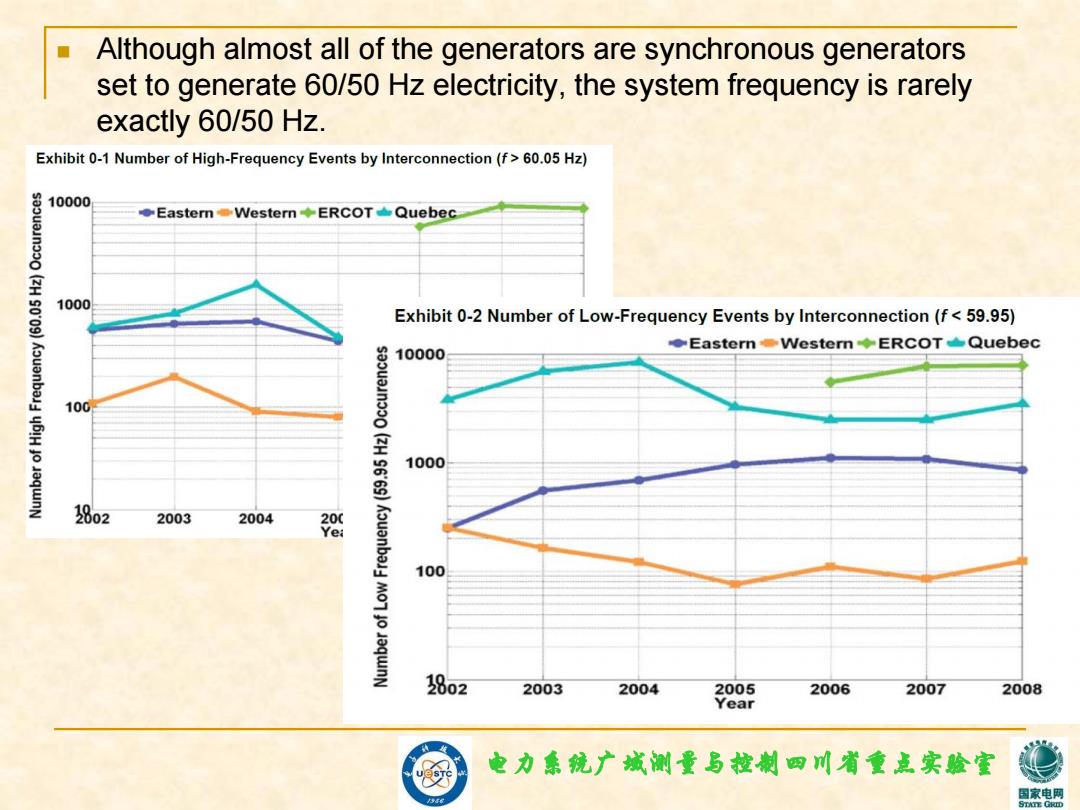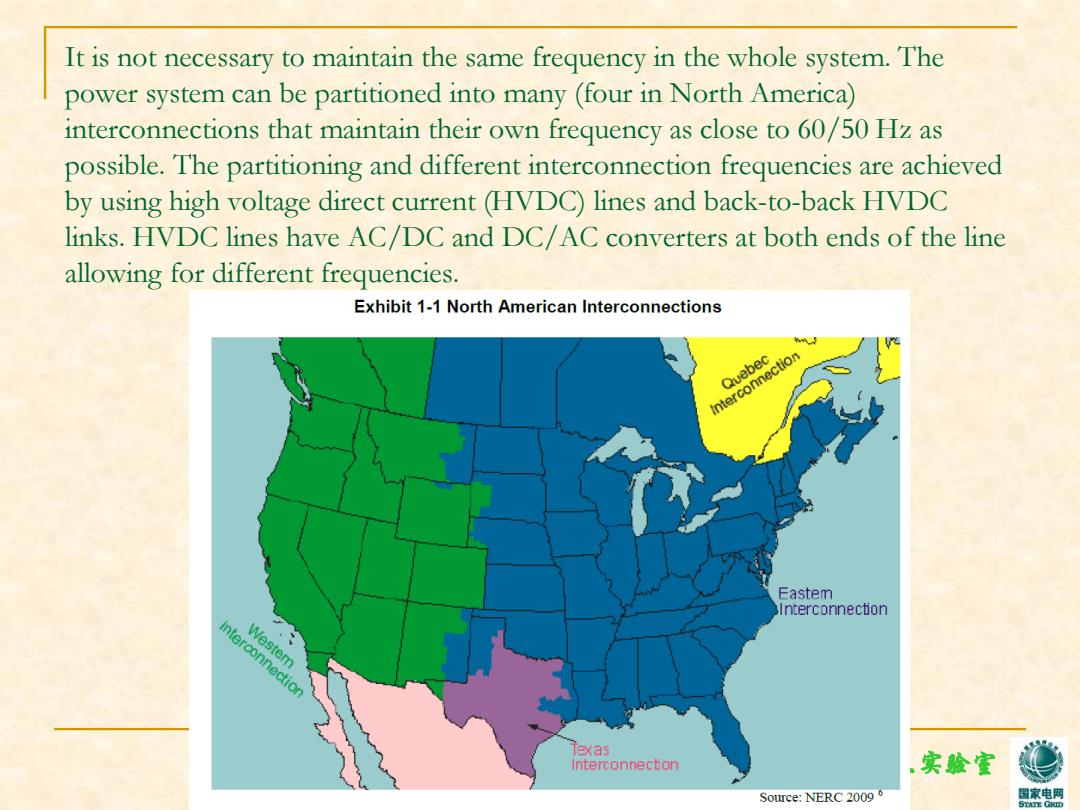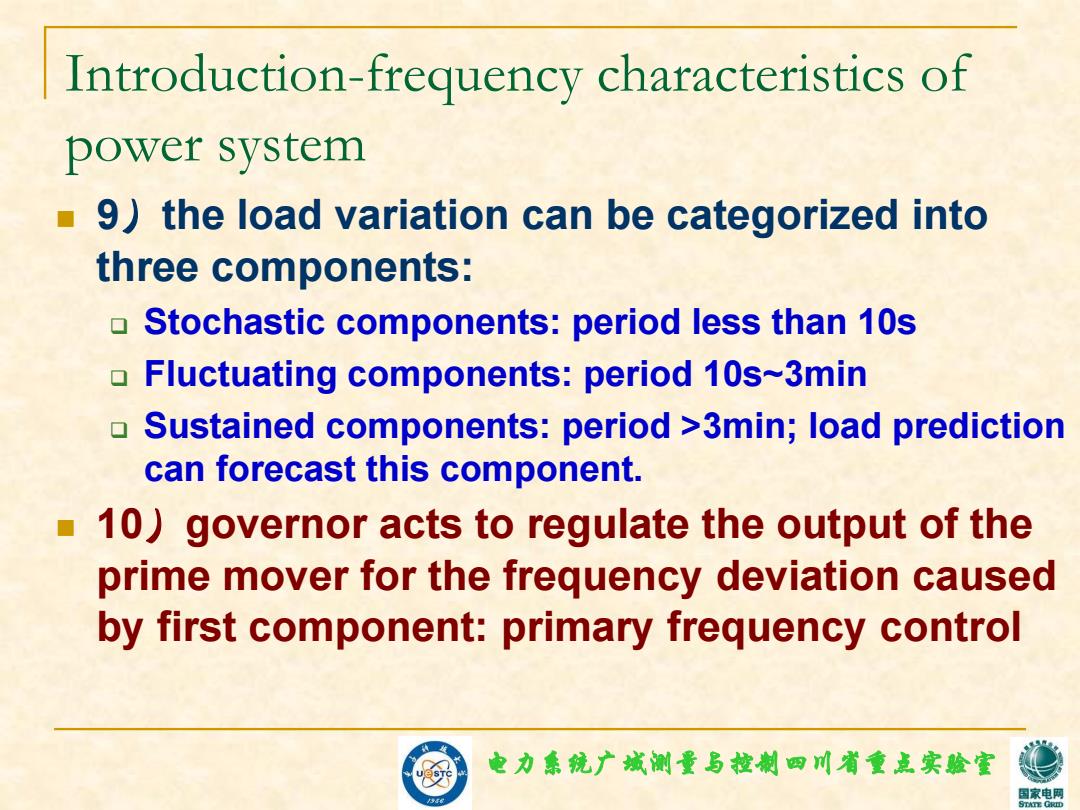
Although almost all of the generators are synchronous generators set to generate 60/50 Hz electricity,the system frequency is rarely exactly 60/50 Hz Exhibit 0-1 Number of High-Frequency Events by Interconnection(f>60.05 Hz) 10000 Eastern●Vestern◆ERCOT◆Quebec 1000 Exhibit 0-2 Number of Low-Frequency Events by Interconnection(f<59.95) 10000 ◆Eastern。NWestern◆ERCOT◆Quebec 100 1000 802 2003 2004 0 100 802 2003 2004 2005 2006 2007 2008 Year 电力拿镜广城洲量写控制四川省童点实验蜜 家电
电力系统广域测量与控制四川省重点实验室 Although almost all of the generators are synchronous generators set to generate 60/50 Hz electricity, the system frequency is rarely exactly 60/50 Hz

It is not necessary to maintain the same frequency in the whole system.The power system can be partitioned into many (four in North America) interconnections that maintain their own frequency as close to 60/50 Hz as possible.The partitioning and different interconnection frequencies are achieved by using high voltage direct current (HVDC)lines and back-to-back HVDC links.HVDC lines have AC/DC and DC/AC converters at both ends of the line allowing for different frequencies. Exhibit 1-1 North American Interconnections interconnection Quebec Eastem Interconnection interconnection Westem Texas Interconnection 实验蜜 Source:NERC 20096 家电
电力系统广域测量与控制四川省重点实验室 It is not necessary to maintain the same frequency in the whole system. The power system can be partitioned into many (four in North America) interconnections that maintain their own frequency as close to 60/50 Hz as possible. The partitioning and different interconnection frequencies are achieved by using high voltage direct current (HVDC) lines and back-to-back HVDC links. HVDC lines have AC/DC and DC/AC converters at both ends of the line allowing for different frequencies

Introduction-frequency characteristics of power system 9)the load variation can be categorized into three components: Stochastic components:period less than 10s Fluctuating components:period 10s~3min Sustained components:period >3min;load prediction can forecast this component. 10)governor acts to regulate the output of the prime mover for the frequency deviation caused by first component:primary frequency control 电力拿镜广城洲量写控制四川省重点实验蜜 家电网
电力系统广域测量与控制四川省重点实验室 9)the load variation can be categorized into three components: Stochastic components: period less than 10s Fluctuating components: period 10s~3min Sustained components: period >3min; load prediction can forecast this component. 10)governor acts to regulate the output of the prime mover for the frequency deviation caused by first component: primary frequency control Introduction-frequency characteristics of power system

Introduction-frequency characteristics of power system 11)the frequency deviation caused by second components is larger,must be controlled by frequency regulator:secondary regulation of frequency 12)the third component is in the dispatch plan of operators:tertiary frequency regulation 电力镜广城测量与控制四川省重点实验蜜 家电网
电力系统广域测量与控制四川省重点实验室 11)the frequency deviation caused by second components is larger, must be controlled by frequency regulator: secondary regulation of frequency 12)the third component is in the dispatch plan of operators: tertiary frequency regulation Introduction-frequency characteristics of power system

Introduction ED and UC establish the optimal operation point based on economic consideration (how to implement it?) Operation point is implemented by generation control: Local control of every generator 口 Large system control and interconnection control at operation center Area control of multiple power network and Independent Power Produces (IPP's) ISO-Independent System Operator RTO-Regional Transmission System Operator 电力镜广城测量乌控制四川省重点实验蜜 家电网
电力系统广域测量与控制四川省重点实验室 Introduction ED and UC establish the optimal operation point based on economic consideration (how to implement it?) Operation point is implemented by generation control: Local control of every generator Large system control and interconnection control at operation center Area control of multiple power network and Independent Power Produces (IPP’s) ISO - Independent System Operator RTO - Regional Transmission System Operator